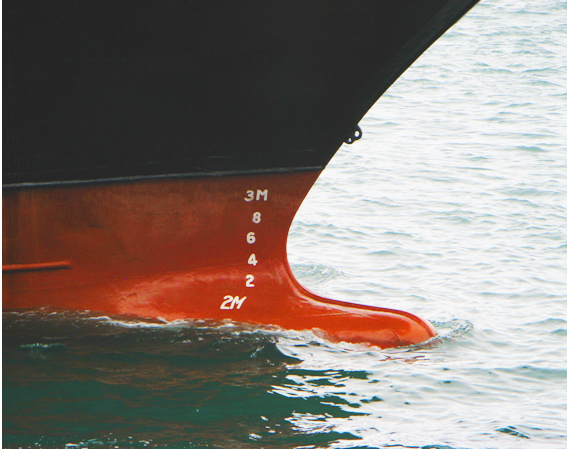 A recent study published by I-Tech AB proved that barnacle fouling is a big headache for the global fleet, even before the Covid-19 forced thousands of ships into warm lay up. The company’s Technical Director, Dr Markus Hoffmann believes that with the high level of idle container ships there will be more hard fouling on hulls than ever before. Here he details the findings of the ground-breaking study and why barnacle fouling is just so bad for the bottom line.
A recent study published by I-Tech AB proved that barnacle fouling is a big headache for the global fleet, even before the Covid-19 forced thousands of ships into warm lay up. The company’s Technical Director, Dr Markus Hoffmann believes that with the high level of idle container ships there will be more hard fouling on hulls than ever before. Here he details the findings of the ground-breaking study and why barnacle fouling is just so bad for the bottom line.
As the public health measures to contain the devastating impact of Covid-19 placed four billion people on lockdown, the commercial effects on the container shipping industry have been immense.
According to Alphaliner, the beginning of June saw the inactive global containership fleet stand at 2.72 million TEU, representing 11.6% of the overall fleet capacity. However, as June progressed, the number of idle containerships appeared to peak, with the overall fleet capacity sitting at anchor having decreased to 2.61 million TEU. Although this downward trend is likely to continue as things start to pick up, containerships are still at great risk from suffering the aftereffects. This includes a profit margin-hitting problem exacerbated when ships sit idle: barnacle fouling.
Biofouling, the attachment of marine organisms to the hull of a ship, has been a perennial headache for the shipping industry for centuries, and it is a particular problem for high fuel consumers such as container ships. While the shipping industry has been ravaged by the economic impact of Covid-19, below the waterline, the hulls of idle vessels will have been ravaged by marine creatures making a home for themselves.
Unfortunately, this includes one creature that has the most impact on ship operating costs, the not so humble barnacle.
In recent months, the pressure on antifouling coatings to function for long static periods has put them in the most testing period encountered so far. Most coating systems rely on the movement of a vessel through water for optimal performance and when a ship sits idle for more than a couple of weeks then real problems can start to arise.
A common feature across the entire spectrum of ship types operating in the shipping industry is that it is very likely that there are significantly more vessels idle now than there was this time last year. When it comes to biofouling risk, the entire global fleet has been in the same boat (excuse the pun).
Clarksons Research predicted in April that 2020 could see global seaborne trade shrink by 5%, the biggest annual decline the sector has seen in 35 years. With global manufacturing at an all-time low, as seen with the US vehicle sector (27% reduction in sales outlook), EU manufacturing down to its lowest level since 1997 and the Nikkei manufacturing Purchasing Manager’s Index almost halving in April, an overall 5% decline could be the minimum level of shrinkage that we see. Albeit, signs show that there are some green shoots of recovery that is pushing container shipping back towards normality.
In the future, protection against what lurks below the waterline is a must for the industry. As ships start to set sail once again, operators may find that performance has decreased, fuel bills are higher and investments in operating budgets may need to be taken to remove biofouling. If barnacle fouling has taken hold on a hull, harsher removal methods may be required which requires higher cost and possible detriment to the antifouling coating. Therefore, in future, the best strategy would be to prevent barnacle fouling from taking hold when a vessel is sat still for more than a few weeks at a time. In an industry where the next global downturn or pandemic could render thousands of containerships idle once more, a future-proofing approach is needed against biofouling, particularly when the risk of barnacle fouling was already quite high even before the Covid-19 pandemic, as discovered through a highly significant research findings published by I-Tech.
In an industry where the next global downturn or pandemic could render thousands of containerships idle once more, a future-proofing approach is needed against biofouling, particularly when the risk of barnacle fouling was already quite high even before the Covid-19 pandemic, as discovered through a highly significant research findings published by I-Tech.
As the developers of a barnacle-repelling biotech ingredient for antifouling coatings – Selektope – gauging the status of barnacle fouling across the global fleet is of great importance. Therefore, we contracted independent marine coating consultants Safinah Group, to undertake a research study to ascertain the extent to which barnacle fouling actually impacts the global fleet.
For the research study, Safinah Group analysed underwater hull fouling conditions on a sample of 249 ships which drydocked over a four-year period between 2015-2019. The sample included all major ship types covering a range of trading activity.
The discoveries were shocking. It was found that nearly every vessel surveyed had some degree of underwater hull hard fouling. On 44% of vessels surveyed, over 10% of the underwater hull surface was covered with hard fouling. Anything more than 10% coverage is deemed to cause an ‘unacceptable’ impact on vessel performance by experts.
On many of the vessels surveyed, fouling levels were even worse; approximately 15% of vessels had between 10-20% of hard fouling coverage on the hull, 10% of vessels had 20-30% of hard fouling coverage and the remaining 10% of vessels had between 40-80% of hard fouling coverage.
The significant costs created biofouling accumulation on a ship’s hull comes from increased hydrodynamic drag that creates a higher demand for shaft power to maintain a ship’s speed which requires more fuel burn. Or if a ship is operating on a fixed shaft power, speed losses are the result. As mentioned, routine hull grooming costs for soft fouling removal (slimes) also increase as biofouling increase, when it comes to hard fouling removal the consequences are much greater as more abrasive methods are required.
Extrapolating from published data taken from a 2011 study by Michael P. Schultz, this level of hard fouling (assuming a 10% coverage of hard fouling on 40% of the fleet) could be responsible for at least 110 million tonnes of excess carbon emissions, and an additional US$6 billion spent on fuel per year for the global commercial fleet. The true figure is likely to be higher, as this is a conservative calculation based on today’s relatively low fuel prices.
Since this data analysis was carried out before the Covid-19 pandemic, we anticipate that in recent months, the extent of barnacle fouling coverage across the global fleet will have increased significantly, particularly for the huge proportion of vessels that have been idle. We can definitely assume that if this data collection exercise is repeated, we could anticipate a significant spike in the extent of fouling coverage.
The current scenario is presenting one of the most testing times for the industry. While ships are lying idle, owners need to ensure that biofouling, and barnacle fouling in particular, is not impacting vessel efficiency and operating expenditure, and in doing so, eroding the earning potential of vessels when things get back to normal. Containership owners will need to perceive antifouling technology as a priority cost-saving strategy for weathering any future economic storms.
An immediate route an owner can take towards being proactive with prevention on fouling is by examining the idle period guarantees within the technology mix in their existing coatings.
For most antifouling coatings, protection guarantees offered by the antifouling coating manufacturer range between 14 and 21 idle days, with the most premium antifouling coatings coming with up to 30 days idle guarantee.
In an ideal scenario, owners need longer protection against biofouling during unplanned idle periods. Therefore, antifouling coatings with longer idle period guarantees of at least 45 days are the best bet.
This isn’t a futuristic wish list, technology exists, such as Selektope, which enables the extension of idling guarantees for antifouling coatings. Therefore, making the jump to coatings that include superior protection against fouling during long idling periods or warm lay ups may be, in the future, what defines profit and loss amongst the various lines in the sector.
Dr Markus Hoffmann has served as the Technical Director at I-Tech since 2017 and is responsible for all R&D activities relating to the use of the ingredient technology Selektope in marine coatings and other applications. He joined I-Tech following an eight-year period in the role of Subject Matter Expert Antifouling Coatings Research and Development at Hempel A/S.







